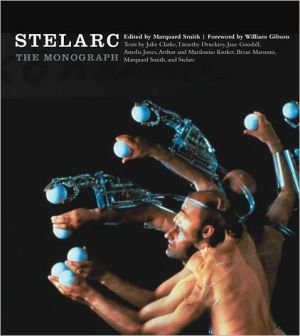

 |

|

The average rating for Stelarc: The Monograph based on 2 reviews is 3.5 stars.
Review # 1 was written on 2011-02-05 00:00:00 James Hamilton James HamiltonStelarc: the Monnograph is a collection of essays written about the body/technology art installation projects of the artist Stelarc. Jane Goodall looks at the installations in terms of their portrayal of the organic and the possible evolutions of technology. Timothy Druckery takes a media archaeology perspective, using Stelarc's work as a jumping off point to consider various historical relations between humans and our technologies. Arthur and Marilouse Kroker consider, somewhat breathlessly, the science (and science fiction) potential of Stelarc's work. Amelia Jones tackles potential problems with Stelarc's approach, and its potential privileging of the white male body. Brian Massumi argues that the project spans the poles between sensation and thought. Julie Clarke considers Stelarc's use of prosthetics and body extensions, centering her essay around his extended ear project. And finally, in the last chapter, the book's editor, Marquad Smith, interviews Stelarc. A lot of the essays tend towards hyperbole, but I suppose that such tendencies are to be expected when discussing a man who had himself suspended naked by hooks with his eyes and mouth sewn shut. I enjoyed Amelia Jones' more critical approach, and Julia Clarke's essay was a good in-depth examination (not coincidentally, they were also the two most straight-forward essays of the bunch). Though the argument and language was rather complex, I also enjoyed Brian Massumi's essay for its concepts relating to the field of perception and sensation. |
Review # 2 was written on 2017-08-03 00:00:00 Chris Williams Chris WilliamsI'm starting reading this as a reference for my master dissertation that focused on the reciprocity between technology and body that implemented as performance art'at that time, my reading of this monograph is actually just to grasped some idea on human-technology relation in performance art. I start reread this monograph weeks ago and discovered many interesting ideas. This time I see Stelarc's work as a monument of how technology could outperformed the functionality of the body. The notion of outperforming our capability as human is always interesting. The mechanism built in most of Stelarc's piece has a sense of animism. Like a beast that is greater than us'the human, the body. Is it post-humanism? I don't know, but at least through his work the co-existence between human and technology as monistic singularity is presented. The essays written on this monograph focus on several aspect of Stelarc's works. From its media archeology to the debate on the difference between culture-nature and from the controversial Stelarc statement 'the body is obsolete' to his tendency of being masochist. Brian Massumi even wrote a 40 pages essay of the genealogy of Stelarc's works'which is amazing. A critique of Stelarc's works is also provide in this monograph. One that I found interesting is by Amelia Jones. She points out the masculinity in Stelarc work. For her, most of the work is a fantasy of control and domination. Putting the body as merely just an object. Jones sees Stelarc works in a feminist perspective that I think critical and important. This raise a question'although Stelarc argues that in this nature of feedback loop between human and technology is endless and thus the question of which in control is less meaningful'perhaps technological development in Stelarc work is indeed a fantasy of control and domination? This supported by how the looks of this technology somehow rigid and less fluid. There is an interesting argument written by Julie Clarke on the aesthetic of Stelarc's work. Clarke theory is that looking Stelarc's work as an aesthetic practice in hostility. She argues that Stelarc willingness to lend his body as a mechanism and habitat for other unknown entities'machinery, computer and even mutational transgenic'could considered as the practice of human hostility. How Stelarc's eagerness to use his own body as the sole experiment in the context of reciprocity between human and machine is an attempt to destroy the border between subject and object argued Clarke. In this sense, Stelarc's statement on the idea of 'the body is obsolete' is applied through his willingness to use his body as medium. The body is just an object. Somehow through Stelarc's work we shall alerted to the facts that human bodily material is appropriated, trademarked and copyrighted by biomedical corporation for their own economic purpose with or without our consent. And here, we have Stelarc'that with his consent of appropriating his body through art'try to proved that there are open possibilities for cybernetics culture that is yet to explore by the human nature without the necessity of involving economic purpose. |
CAN'T FIND WHAT YOU'RE LOOKING FOR? CLICK HERE!!!